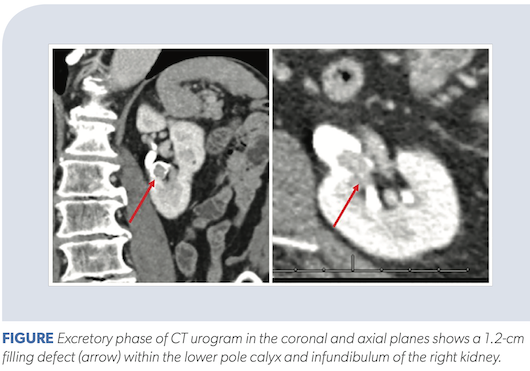Article
Management of UTUC using a kidney-sparing approach
Author(s):
Advances in endourology have made kidney-sparing treatments a viable treatment option.
Dr. Watson is a urology resident at William Beaumont School of Medicine, Royal Oak, MI, and Dr. Hafron is a partner at the Michigan Institute of Urology, P.C. and associated professor of urology at William Beaumont School of Medicine.
The Case
An 84-year-old man presented to the urology department following an episode of painless gross hematuria. His medical history was significant for atrial fibrillation (for which he takes warfarin), coronary artery disease, and BPH. He had a significant smoking history with one to two packs of cigarettes per day for 75 years. His glomerular filtration rate was estimated at 60 mL/min/m2.
CT urogram revealed a 1.2-cm enhancing lesion within the left lower pole infundibulum (figure). Urine cytology was suspicious for a low-grade lesion.
The patient was taken to the operating room to undergo cystoscopy and flexible ureteroscopy. No lesions were seen in the urethra or bladder. On pyeloscopy, a large pedunculated soft tissue mass was seen filling the lower pole of the kidney.

The surgeon biopsied the mass with a 3F Piranha Ureteroscopic Forceps and placed a ureteral stent. Pathologic analysis revealed low-grade papillary transitional cell carcinoma without muscular invasion (pT1, stage 1).
After a discussion of the various treatment options, the patient elected to undergo endoscopic management. He was taken back to the operating room for ureteroscopy fulguration using a 3F monopolar Bugbee electrode. Fulguration was continued until no visible tumor was seen and margins appeared clear. The patient was then started on a surveillance protocol with urine cytology, CT urography, and cystoscopy with ureteroscopy.
During the first surveillance ureteroscopy at 3 months, a small recurrence of low-grade UTUC was seen in the kidney and was treated endoscopically. The ureteroscopy interval was then increased to every 6 months for 1 year and then to every 12 months. CT urography (CTU) is performed annually, and there have been no further recurrences 39 months after the initial treatment.
Presentation and diagnosis
UTUC is an uncommon malignancy, accounting for just 5% to 10% of all urothelial carcinomas (UCs). UC tends to be a multifocal disease, and approximately 17% of those with UTUC will have concurrent UC of the bladder.1 The majority of patients with UTUC present with hematuria. Ureteral obstruction with flank pain occurs in 20% to 40% of patients.2
The European Association of Urology (EAU) and National Comprehensive Cancer Network (NCCN) have similar guidelines for the diagnostic workup of suspected UTUC.3,4 In addition to the testing noted in the information to follow, the NCCN guidelines recommend renal function testing and chest x-ray for all patients. The AUA does not currently have guidelines specific to UTUC.
CTU is the preferred imaging modality for diagnosis of UTUC. An enhancing mass or thickening of the urothelium should prompt further evaluation. Hydronephrosis may be seen and is an independent predictor of muscle invasion and high-grade disease.5 For patients who cannot undergo CTU due to iodinated contrast allergy or impaired renal function, magnetic resonance urography with gadolinium-based contrast is an alternative.
Cystoscopy should be performed to rule out UC of the bladder. Retrograde pyelography may be performed at the time of cystoscopy, and solitary filling defects and hydronephrosis are the most common abnormal findings. Urine cytology should be obtained as well. Cytology has a lower sensitivity for UTUC than for UC of the bladder and should be obtained in situ from the renal pelvis.6 Diagnostic flexible ureteroscopy is mandatory and allows for direct visualization of the entire upper urinary tract. Biopsy samples should be taken to confirm the diagnosis and stage the tumor.
Ureteroscopic biopsy specimens can make accurate staging difficult. In our case, we used ureteroscopic biopsy forceps, but many have reported improved yield with an endoscopic stone basket. Several novel imaging techniques to be used in conjunction with ureteroscopy such as narrow band imaging (NBI), photodynamic imaging (PDI), and optical coherence tomography (OCT) are under investigation. NBI for the upper tract is commercially available as an extension of the currently available systems used for NBI cystoscopy, PDI systems are commercially available and currently used primarily for bladder lesions, and OCT is investigational for urologic purposes (current systems are for ophthalmologic diagnostics).8
Risk stratification
Proper risk stratification is critical when considering patients for a kidney-sparing approach. UTUC that invades the muscular wall (≥pT2) carries a poor prognosis with a 5-year survival rate <50%.9 Given the available diagnostic tools and challenges with obtaining an adequate biopsy, accurate assessment of tumor stage remains a challenge. Therefore, the EAU proposes a classification in which tumors are stratified as low or high risk based on a number of tumor-related factors (table).10
Management
Radical nephroureterectomy (RNU) with bladder cuff excision is the gold-standard treatment for UTUC. More recently, advances in endourologic equipment and techniques have allowed kidney-sparing treatments to become a viable management option. These kidney-sparing surgeries should be reserved for patients with low-risk UTUC or those with imperative indications such as solitary kidney, impaired renal function, or severe comorbidities.11
Endoscopic ablation. Endoscopic ablation is most commonly performed in a retrograde fashion. A percutaneous approach can also be employed for difficult-to-reach calyceal tumors, although advances in ureteroscope maneuverability make this technique rarely necessary. Once the tumor is visualized, an energy source is used to ablate the tumor and its base. This step can be achieved with electrocautery (typically a 3F monopolar Bugbee electrode) or laser energy. There is a high rate of recurrence ranging from 30% to 70%.12 Most recurrences are low grade and patients must be willing to undergo strict surveillance.
NCCN and EAU guidelines advise urine cytology and CTU at 3 months, 6 months, and then annually. Cystoscopy with ureteroscopy with selective cytology should be performed at 3 months, 6 months, every 6 months for 2 years, then annually. For low-grade, low-stage tumors, oncologic outcomes are similar between those treated with endoscopic ablation and those undergoing RNU.13
Intracavitary topical therapies. Bacillus Calmette-Guerin (BCG) and mitomycin C are commonly instilled within the bladder for the treatment of CIS and to reduce recurrence of nonmuscle-invasive UC. There is interest in applying these topical therapies to the upper tract to reduce recurrence after endoscopic ablation. Instillation of several agents, including BCG and mitomycin C has been described, but the optimal dosing and instillation strategy are unclear.
Antegrade infusion via nephrostomy, retrograde infusion via ureteral catheter, and reflux via a double-J stent have all been described, but achieving an adequate dwell time remains a challenge. To address this issue, a novel formulation of mitomycin C combined with a reverse-thermal gelation hydrogel (UGN-101) has been developed and is currently under investigation. This compound is liquid when cool and solidifies to a gel at body temperature, providing a sustained release of mitomycin C. Early results of 68 patients with unresectable low-grade UTUC in the OLYMPUS trial show a 60% complete response to induction therapy.14
Segmental resection. For patients with UTUC of the distal ureter, distal ureterectomy with neocystostomy may be offered. This is the preferred treatment option for low-grade tumors but can be offered for high-grade tumors if preservation of renal function is required. Segmental resection of the mid and proximal ureter is also an option for low-grade tumors.
Radical nephroureterectomy. RNU with bladder cuff resection is the only curative option for patients with UTUC. Patients with high-risk UTUC should be offered RNU if they have adequate renal function and are acceptable candidates for major surgery. Open, laparoscopic, and robotic approaches have been described, with no difference in oncologic outcomes among these techniques.15 The role of regional lymph node dissection remains controversial. Current guidelines recommend node dissection for patients with high-risk tumors.16 No standardized template exists for lymphadenectomy. Recurrence of UC in the bladder following RNU for UTUC is 22% to 47%, and a single postoperative dose of intravesical chemotherapy immediately following surgery reduces this risk.17
There are several ongoing clinical trials evaluating the role of neoadjuvant chemotherapy for UTUC. Although no level 1 evidence currently exists, retrospective analyses have shown improved disease-specific and overall survival with platinum-based regimens.18
Conclusion
Kidney-sparing surgery is an acceptable alternative to RNU in appropriately selected patients with low-grade UTUC. Proper risk stratification including endoscopic biopsy is critical when considering a kidney-sparing approach. Due to high recurrence rates, close surveillance is also mandatory.
References
1. Cosentino M, Palou J, Gaya JM, et al. Upper urinary tract urothelial cell carcinoma: location as a predictive factor for concomitant bladder carcinoma. World J Urol 2013; 31:141-5.
2. Raman JD, Shariat SF, Karakiewicz PI, et al. Does preoperative symptom classification impact prognosis in patients with clinically localized upper-tract urothelial carcinoma managed by radical nephroureterectomy? Urol Oncol 2011; 29:716-23.
3. Rouprêt M, Babjuk M, Compérat E, et al. European association of urology guidelines on upper urinary tract urothelial carcinoma: 2017 update. Eur Urol 2018; 73:111-22.
4. NCCN Clinical Practice Guidelines in Upper GU Tract Tumors. 2020; Accessed 3/3/20. NCCN website. www.nccn.org.
5. Messer JC, Terrell, JD, et al. Multi-institutional validation of the ability of preoperative hydronephrosis to predict advanced pathologic tumor stage in upper-tract urothelial carcinoma. Urol Oncol 2013; 31:904-8.
6. Messer J, Shariat SF, Brien JC, et al. Urinary cytology has a poor performance for predicting invasive or high-grade upper-tract urothelial carcinoma. BJU Int 2011; 108:701-5.
7. Kleinmann Nir, et al. Ureteroscopic biopsy of upper tract urothelial carcinoma: comparison of basket and forceps. J Endourol 2013; 27:1450-4.
8. Knoedler JJ, Raman JD. Advances in the management of upper tract urothelial carcinoma: improved endoscopic management through better diagnostics. Ther Adv Urol 2018; 10:421-9.
9. Abouassaly R, Alibhai SM, Shah N, Timilshina N. Troubling outcomes from population-level analysis of surgery for upper tract urothelial carcinoma. Urology 2010; 76:895-901.
10. Rouprêt M, Babjuk M, Compérat E, et al. European association of urology guidelines on upper urinary tract urothelial carcinoma: 2017 update. Eur Urol 2018; 73:111-22.
11. Rouprêt M, Babjuk M, Compérat E, et al. European association of urology guidelines on upper urinary tract urothelial carcinoma: 2017 update. Eur Urol 2018; 73:111-22.
12. Cutress ML, Stewart GD, Zakikhani P, et al. Ureteroscopic and percutaneous management of upper tract urothelial carcinoma (UTUC): systematic review. BJU Int 2012; 110:614-28.
13. Seisen T, Peyronnet B, Dominguez-Escrig JL, et al. Oncologic outcomes of kidney-sparing surgery versus radical nephroureterectomy for upper tract urothelial carcinoma: a systematic review by the EAU Non-muscle Invasive Bladder Cancer Guidelines Panel. Eur Urol 2016; 70:1052-68.
14. Kleinmann N, Gan R, Matin S, et al. Nephron-sparing Management of low Grade (lG) UTUC with UGN-101 (mitomycin gel) for instillation: The Olympus Trial Experience. J Urol 2019; 201 (suppl 4, abs. lBA-16): e999-e999.
15. Clements M, Krupski T, Culp S. Robotic-Assisted Surgery for Upper Tract Urothelial Carcinoma: A Comparative Survival Analysis. Ann Surg Oncol 2018; 25:2550-62.
16. RoupreÌt M, Babjuk M, CompeÌrat E, et al. European association of urology guidelines on upper urinary tract urothelial carcinoma: 2017 update. Eur Urol 2018; 73:111-22.
17. Fang D, li XS, Xiong GY, et al. Prophylactic intravesical chemotherapy to prevent bladder tumors after nephroureterectomy for primary upper urinary tract urothelial carcinomas: a systematic review and meta-analysis. Urol Int 2013; 91:291-6.
18. Porten S, Siefker-Radtke AO, Xiao l, et al. Neoadjuvant chemotherapy improves survival of patients with upper tract urothelial carcinoma. Cancer 2014; 120:1794-9.
Newsletter
Stay current with the latest urology news and practice-changing insights — sign up now for the essential updates every urologist needs.

















